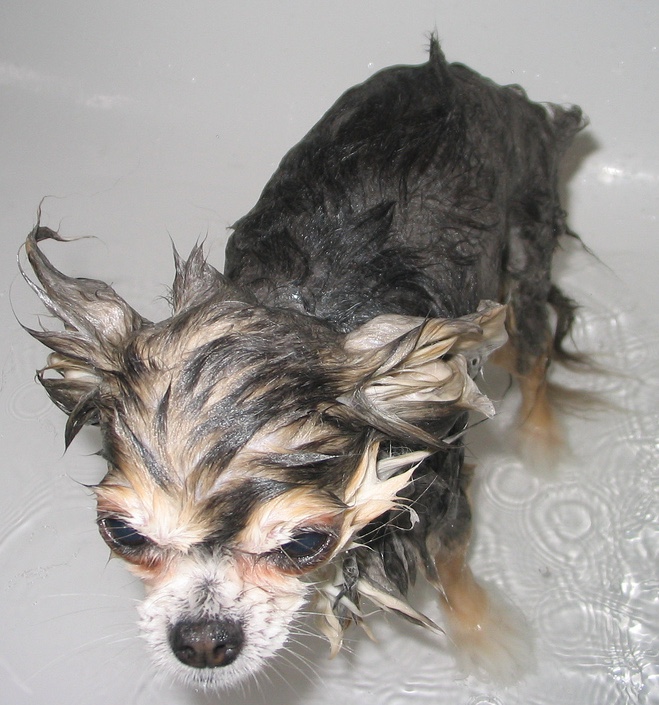PLEASE NOTE: Dog Garden Flags are currently unavailable. Please check back later. Thanks for your interest.
Spotting Allergies
In Dogs

Dog Allergies
Treating allergies in dogs is a little trickier than treating people. This page is dedicated to helping you solve the allergies that might be affecting your dog, but we also cover human allergies to dogs if you've reached this page in error.
If your dog has allergies, the signs are hard to miss. And if you suspect your dog has allergies treating him could be very simple.
They most commonly seen allergies in dogs are skin-related, but airborne allergies and food allergies are also common. Least common would be allergic reactions to household items like detergents, etc.
Many dog breeds are actually prone to allergies like, Shih Tzus, Chinese Cresteds and Bichons, just to name a few.
More of the most common allergies are listed Below.
Most Common Dog Allergies
Is your dog licking, scratching, biting, pulling out fur, scooting, rubbing his face or any combination of these or other things that make him seem obsessed and miserable?
He most likely has a skin (atopic) allergy.
Allergies that affect the skin aren't the only allergies. Dogs can be allergic to many different things and the list in endless. All of the same things that can cause allergic reactions in people can also affect dogs, including, but not limited to:
- Fleas;
- Grass;
- Chemicals (flea collors, soaps, household cleaners...);
- Dust mites;
- Latex;
- Cats;
- Other dogs;
- Many different kinds of food (chicken, gluten and other grains, peas, shellfish, nuts...);
- And More!
Flea Allergies: Symptoms and Treatment

If you have a dog that suffers with flea allergies, you may have noticed one or more of the following symptoms:
Incessant Scratching
Licking of Paws or discoloration of fur caused by excessive licking
Swollen Paws or areas of redness between toes.
Chewing and Pulling out of fur
Localized/Patchy Fur Loss
Scaly or Red Skin Irritation
Skin Lesions, rashes, bumps, etc.
Face Rubbing
Flea Allergy Treatment:

Step #1. Get rid of the fleas.
Finding the right treatment that will actually work for your dog can be tedious, admittedly, but who wants to live with fleas? Over-the-counter treatments like flea drops sometimes work but there are other more effective treatments available.
Talk to your vet about once monthly medications that can be given orally.
Luckily, for most dogs, a simple pill can be given so there's little need for bargain products like flea collars and flea shampoos. These products work to kill and repel fleas in the short term, but they require a lot more hands-on work and aren't nearly as effective, especially in the long term.
Between The Shoulder Blades Flea Drops are a Temporary Cure. But Don't Over-use Them!
Don't underestimate the power of flea drops, but also do not over-use them. The over-use of flea drops can over-dose your dog.
The active ingredient in flea drops will depend on the brand you choose, but it's important to follow the weight guidelines for administering the drops closely. Never replace the flea drops meant for dogs with flea drops meant for cats. The dosages are very different and the consequences could be very serious.
The drugs in these flea drops are absorbed through the skin of your pet, so if you've already tried one brand without success, never administer any other topical or oral treatment without first seeking the advice of your veterinarian.
Kill Fleas In The Dryer
Once you've treated the dog, treating your home needs to be done as well.
Wash your dog's bedding regularly. Read the tags on your dog's bed. Most say that you cannot wash them, (I always have anyway, but use your best judgement). Hot water will work best to clean and disinfect.
Fleas and flea larvae can hide in carpet, bedding, furniture, blankets and almost every other soft surface inside your home.
Killing Fleas in the Dryer:
If the bed won't fit inside your washing machine at home, try the larger machines at the laundromat, or simply throw them in the dryer.
The heat of the dryer can kill a lot of bacteria as well as a lot of fleas. Throw in a dryer sheet to freshen it up some and run it for around 20 minutes on a high heat setting.
This method will kill fleas whether you're just between washes or if you had the bed outside and want to make sure you're not bringing in any stragglers. Read the tags if you're concerned about the fabric. For most dog beds, the dryer is safe.
Treat the Dog's Allergies As Well As The Cause
Get rid of the fleas outside, too. Consider contacting an exterminator to treat the outside of your home. Treating your yard regularly is another way to ensure effective and long-term eradication of the fleas... and the suffering that can be caused from a single flea bite.
However, if you're more of a do-it-yourself type, like me, or you just don't like the idea of the chemicals in extermination products, there are other options.
Safe, Effective Outdoor Treatment
Products that use essential oils to repel troublesome insects like ticks and mosquitos can be just as effective a the products that use harsh chemicals.
Products that can treat your yard for troublesome pests, but it's still safe for the dog, not to mention you, your children and plants would be a great alternative to giving a pill or calling an exterminator, if you're more of a do-it-yourself-er..
Fleas are disgusting little creatures and even if you're dog isn't allergic to them, it's no way to let your pet live... and if your pet is living with them, then so are you.
This product uses no harsh chemicals.
As an Amazon associate, I may earn a small commission if you purchase a product you saw here.
Signs, Symptoms and Treatment of Allergies in Dogs.
Fleas aren't the only allergen that can affect your pet. Dogs can be allergic to some of the same things people are, like mold, bacteria, pollen, grass, wool and even certain foods... just to name a few.
The symptoms of airborne allergies in dogs are about the same as those mentioned above. In addition, you might also notice a lot of sneezing or snorting. If you notice frequent digging of ears, check for signs of infection brought on by a possible allergic reaction.
There are other ways of treating allergies in dogs.I'm not a vet, so I can't recommend medication or dosage. I have given my own dogs Benadryl by googling the appropriate dosage (then confirming it with my vet), to relieve symptoms of allergies in my dogs, but every dog and situation is different. Call you veterinarian for advice on dosage before giving your dog any over-the-counter human medication, oral or topical.

If symptoms are affecting your dog's ability to function normally, please call your vet as soon as possible. Only a veterinarian can accurately detect what your dog is allergic to. Treating allergies in dogs is surprisingly simple and inexpensive. Don't be scared off by the possibility of expense.
Most veterinarians, when asked, will advise you on how to treat your dog at home if regular office visits for treatment exceed your budget. Anyone with allergies knows how unpleasant they can be, so don't make your dog suffer any longer than you would let yourself or your child.
Our Most Popular Pages
Home l Dog Training and Housebreaking l List of Small Dog Breeds l Pet Steps
Our Mission
Our mission is to help dogs... Because we care. Deeply. Please let us know if there's any way we could have made your small-breed-dogs.com experience better. Helping your means helping dogs We also welcome you to contact us if there are
any other questions we can answer for you about Allergies in Dogs.
Learn more about me, my art, the mission of this site and Rescue Dogs Are Better here.
As an Amazon associate, I may earn a small commission from purchases made through this site.
Please help spread awareness to the plight of puppy mill dogs and hopefully one day put an end to them.
We also welcome you to contact us if there are any other questions we can answer for you about anything you saw or read on this site.


New! Comments
Leave us a comment if you have something you'd like to share or add to what you just read here. Or contact us with questions or comments.